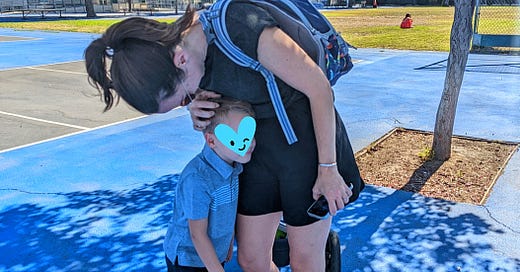Restraint Collapse is So Real
How I manage it with my kids and how I am thinking about it for myself.
Welcome to So Many Thoughts, a semi-weekly newsletter about royal style and the other parts of life I want to think through with you. You can subscribe here and follow me on Instagram at @EHolmes. Thank you!
If summer is still going strong where you are, I envy you! School started yesterday here in Los Angeles and all five of us were out the door by 7:30am. Fitzgerald began second grade and Oliver is now in kindergarten. All the feels! Drop-off the first morning went very well. I was the only one who cried. Well, then Bird did, because she missed her brothers.
Jump cut to later that afternoon and everyone in our house was upset about something. It’s a familiar—and loud—moment in the day for us, and I know now it has a name. More on what is happening and how I manage it for my kids (and myself) below. Plus, five recommendations for you.
ICYMI: Lessons I learned back-to-school shopping
Why Your Kids (and Mine!) Melt Down After School
Picking up Oliver after his first day of kindergarten. Let the collapse begin. 💗
One of the strongest memories I have from my early elementary years is how it felt to come home from school. After sitting still in a classroom all day, anxiously trying to follow every rule, every direction, every utterance from my teacher, I would step through the front door of our house and release it all. I would shout, I would cry, I would talk back, I would act out.
Only last fall did I learn there is a name for this phenomenon: after-school restraint collapse. Psychotherapist Nancy Brooks told Motherly that children “will act younger than their age and whine, cry, throw tantrums, act needy, moody and generally have a meltdown.” In our house, the big feelings come out in big ways: Making huge messes, jumping wildly on the couch, shouting at a sibling, bursting into tears. It’s a palpable release, and I’ve learned that the emotions are rarely about what is happening in the moment but more about letting go of the day.
Restraint collapse lessens as kids get older; the Motherly piece puts the turning point at around 12, as they develop more tools for emotional resiliency. But is there such a thing as restraint collapse for adults? Even with our adult-levels of emotional resiliency?
Yes, according to Andrea Loewen Nair, a counselor and parenting educator based in Ontario, Canada. “You conduct, orchestrate, produce, think, smile, keep things in your inside brain that you wish you could say out loud, then walk in your front door only to turn into a snarly, crabby person,” Loewen Nair writes on her site. “It takes a great deal of energy, mental motivation, emotional containment, and physical restraint to keep ourselves at our best while at work, daycare, or school for other people.”
Not to brag, but my kids inherited my best-in-class restraint collapse tendencies. At preschool pick-up, Oliver’s teacher would routinely comment on what a great day he had; by the time we got to the car, that same kid would be howling at me because I brought the wrong snack.
Recognizing this is a thing, not just for our family but for kids everywhere, was hugely helpful. I always find identifying what is happening helps me start the process of managing it. Not solving it, because I don’t think this is something you can solve—and especially not at the start of the school year. Newness heightens restraint collapse for my kids. But I have found ways to manage it. Here are my tips:
Meet kids with an enthusiastic greeting. Years ago, before I had my own kids, I read that you should always greet children with a smile. Even if your toddler trashed the playroom, do not make your first encounter with them a scowl. It’s far too rattling to their little selves. Start with a smile. For school pick-up, I pair a smile with a big, oversize wave. We’re talking an arm-over-the-head wave of an air traffic controller that they can spot across the playground. Even Fitzgerald, who has a skeptical side, will break into a big smile and return the gesture. (I imagine it will be embarrassing at some point, but my kids are still a little young for that.) I often add: “I am so happy to see you!” My goal is to be an enthusiastic and soft spot for them to land.
Try not to ask them about their day (at least not directly). Although my mom brain would like to know every single thing they did at school, I try my hardest to avoid the general “How was your day?” query. I find it much more effective to start talking about my day first, especially if something out of the ordinary happened. “You’ll never guess what I did!” followed by me prattling on always gets them chatting.
Feed them — quickly. Lunchtime at our elementary school is also recess time, which as a parent I have thoughts about! But nobody asked me! When given the choice between eating a sandwich and playing with friends, my kids will always choose the latter. Most days, they are ravenous when they get home. Having a snack ready is key; bonus points if it carries some nutritional value (though tbqh I miss the mark on that regularly; we’re all a work in progress!).
Give them time to decompress in their own ways. This could look very different based on your kid. We walked home from school yesterday in the hot Southern California sun and Fitzgerald asked if he could go play with Legos in the garage. Not the air-conditioned playroom, where there are also Legos. But the garage. That’s what he needed. Oliver, on the other hand, couldn't get inside fast enough to cool down and play with his toys. When we can swing it, I head to a playground and let them run around.
Hear them out. When the meltdown comes, and even with all of the above it usually does, I do my best to listen, affirm, and empathize. It’s the technique and language so many gentle parenting accounts (ie Dr. Becky or @BigLittleFeelings) recommend, saying “I hear you” or “I know you didn’t want that to happen” or “That sounds so hard.” Often, it releases even more, bigger feelings from my kids, which can be hard to stomach. But better out then in, I think. Downplaying or negating the feelings only means they will come out later.
When in doubt, put them in the bath. We reach a point most every weekday where I say (shout?): IT’S BATH TIME. I’m not sure what it is about water that calms kids down, but gosh does it work. Putting one or more of my children in the tub has an instant soothing effect. On the hardest of days, we do Busy Toddler’s popsicle bath.
Look for ways to laugh. Some of my most favorite memories of my mother were when we were doubled over in laughter. My mom wasn’t silly, not exactly. But, gosh, she loved a good pun or joke. Our family loves a good dance party, whether it’s the soundtrack to Encanto or throwbacks Oliver picked up at preschool music class. Also, if they still have not shared about their day, humor can help here, too. Say something ridiculous—“Did a dinosaur walk into your classroom???”—and often they will respond with what did happen.
But mostly: All of this asks a lot of parents at a time when we are already drained. I’ll be the first to admit I don’t always have the energy to summon my sunniest self. These are my goals for every afternoon and if I manage to do one or two, I call it a win.
And speaking of parents…what about parents? I would love for someone to greet me with a smile, feed me a healthy snack, and make me laugh. 🙃 All too often, my version of coping with restraint collapse looks like checking out, scrolling on my phone after I put the kids to bed. Which I do not love.
So! I am trying to be a bit more intentional with my own restraint collapse moments. The first is to recognize when this release will happen. It’s not just after kiddo bedtime, but also after school drop-off, especially on the most frantic mornings. I can feel it after a big meeting or a therapy session, too. Anytime I’m required to hold it all together for a meaningful amount of time.
What to do in the midst of it? I am not sure. Right now, it looks like taking space with boundaries, giving myself permission to transition. Five minutes in the car by myself. One episode of TV after bedtime. I would love to be the person who does yoga at night or goes to sleep early, and occasionally I am. But not often enough. We’re all a work in progress, aren’t we?
How do you handle restraint collapse in your kids—or for yourself? Please share your strategies. Hit “Join the discussion” below and share in the comments.
Five Things To Check Out This Week
READ / Harper’s Bazaar released its ICONS issue, a list of “tastemakers and culture shifters” age 30 and under. The kids are better than alright! (Harper’s Bazaar)
READ / A beautiful essay on acceptance from Andrea Gibson: “When we accept the truth of something, it’s simply common for our minds to go still. And a still mind is a mind that no longer gets in the way of life, of living. A still mind returned me to my heart.” (Things That Don’t Suck Newsletter)
READ / Michelle Obama, Selena Gomez, Nikole Hannah-Jones, and other big names offer tips on what we can do to help democracy, written by my friend Erin Geiger Smith. (Marie Claire)
WATCH / I caved and watched The Dropout. Yes, that one, the one about she-who-shall-not-be-named. And I still won’t say her name! But I will say that the eight-episode series was riveting, in a horrifying way. (Hulu)
SHOP / The very kind folks at Rifle Paper Co sent me a box of goodies, including this tray, tote, and swimsuit. I love them all! You can use code ELIZABETH for 20% off your entire purchase. (Rifle Paper Co)
Note: I use affiliate links, which means that if you make a purchase I may get a small commission at no cost to you. Thank you for supporting my work.
Missed a newsletter? Catch up on the archives (you can filter by topic!) at my new newsletter page on my redesigned website.
And here is the link to the ✏️ teacher supply lists that need clearing! Yes, this concept is problematic (call your local reps and demand better funding) AND yes, teachers need our help. Thank you to the educators among us, your work is the most important.
Have a great week, friends.





